Understanding COVID19 the Indian Way – Immunity Guide to Coronavirus
What is COVID-19?
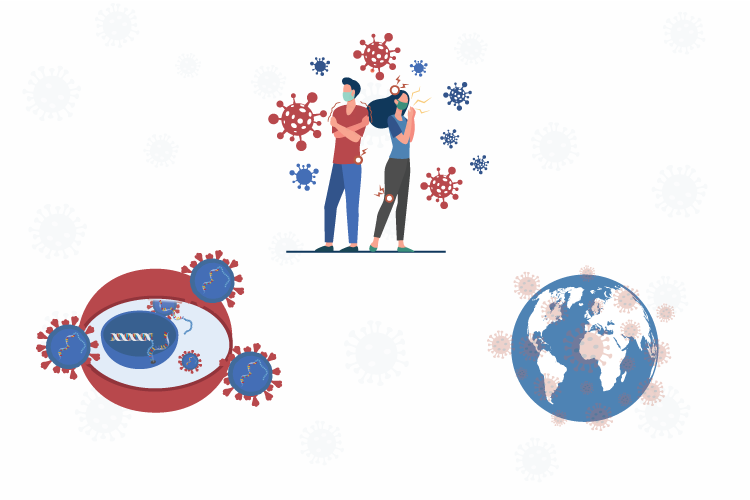 It is a pandemic which was originally abbreviated as 2019-nCoV by WHO. It has been earmarked as a severe acute respiratory syndrome later by WHO. The virus is communicable and hence can spread from person to person. Currently, research is being done to develop a vaccine or cure for COVID-19.
It is a pandemic which was originally abbreviated as 2019-nCoV by WHO. It has been earmarked as a severe acute respiratory syndrome later by WHO. The virus is communicable and hence can spread from person to person. Currently, research is being done to develop a vaccine or cure for COVID-19.
Belonging to Betacoronavirus together with two highly pathogenic viruses, SARS-CoV and MERS-CoV, SARS-CoV-2 is one of the seven types of coronavirus. It is an enveloped and positive-sense single-stranded RNA (+ssRNA) virus. Genomic study indicates that the virus is closely related to bat-derived SARS-like coronaviruses collected in 2018 in Eastern China and genetically distinct from SARS-CoV and MERS-CoV.
Signs and Symptoms of COVID-19
Symptoms of COVID-19 do not reflect at the earliest. It takes between 5 and 14 days for the symptoms to appear. Common symptoms of COVID-19 include:
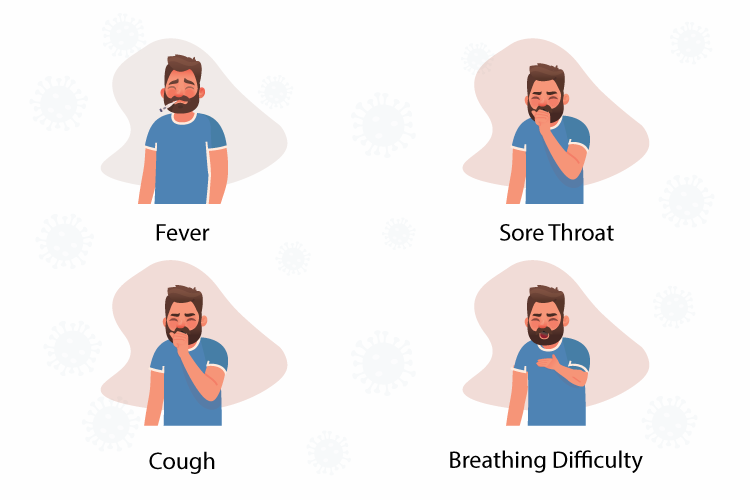
- Fever
- Dry Cough
- Sore throat
Further based on the severity of symptoms can be classified into mild, moderate and severe. The patients have many common features including fever (98.6%), fatigue (69.6%), dry cough, and diarrhea.
Mild Disease
Patients with mild illness have symptoms of an upper respiratory tract or viral which include dry cough, mild fever, nasal congestion, sore throat, headache, muscle pain, and malaise. The majority (81%) of COVID-19 cases are mild in severity.
Moderate Disease
These patients usually show respiratory symptoms of cough, shortness of breath. Breathing that is abnormally rapid and often shallow also known as tachypnea (approximately 20 breaths per minute).
Severe Disease
In severe disease conditions, pneumonia, acute respiratory distress syndrome (ARDS), sepsis, or septic shock are commonly found. Clinical presentations include the presence of severe dyspnea, tachypnea (respiratory rate > 30/minute) and respiratory distress.
Transmission of COVID-19
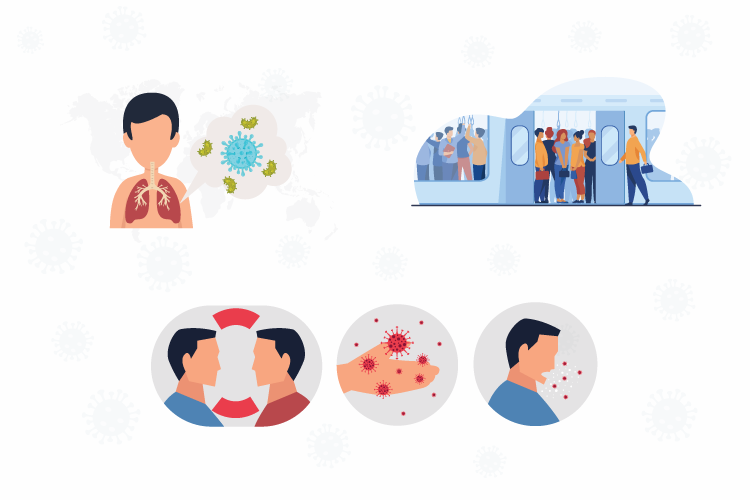
One can get COVID-19 infection through close contact with a person who has symptoms from the virus including cough and sneezing. Transmission occurs from the spread of respiratory droplets through coughing or sneezing. It was observed that coronavirus had spread via airborne zoonotic droplets. The virus multiplies in our ciliated epithelium causing cellular damage and resulting in the infection.
The initial cases of COVID were linked to direct exposure to infected animals at a seafood market in Wuhan, China (animal-to-human transmission). With increased transmission, it became evident that COVID could also be transmitted human-to-human, which is now considered the main form of transmission. Transmission occurs through respiratory droplets from coughing or sneezing, close contact between individuals, and closed spaces which leads to elevated aerosol concentrations. It has been observed through research that SARS-CoV-2 has a basic reproduction number of 2.2, meaning that an infected individual is likely to transmit the infection to two other individuals through the course of their infection
Though the most common source of infection is symptomatic people. Individuals who remain asymptomatic, termed as carriers, could also transmit the virus.
Difference Between Carrier and Victim
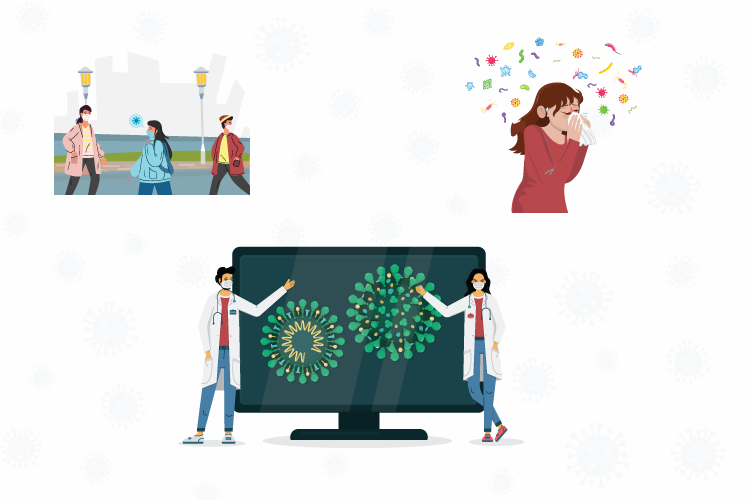
A majority of the infected are carriers and not victims of the disease. A carrier is a person who comes in contact with the virus, is infected, but does not develop any symptoms, yet can transmit the disease to another person. Victims are those who contract the virus, develop symptoms that may vary in severity, and have higher chances of transmitting the virus. Our existing immunity level and existing health issues determine whether the virus becomes symptomatic or not. Due to the strong immunity level of the Indians majority of the population is a carrier, so it advisable to be careful while going out and ideal to maintain social distancing.
The Worst Affected Parts of the World
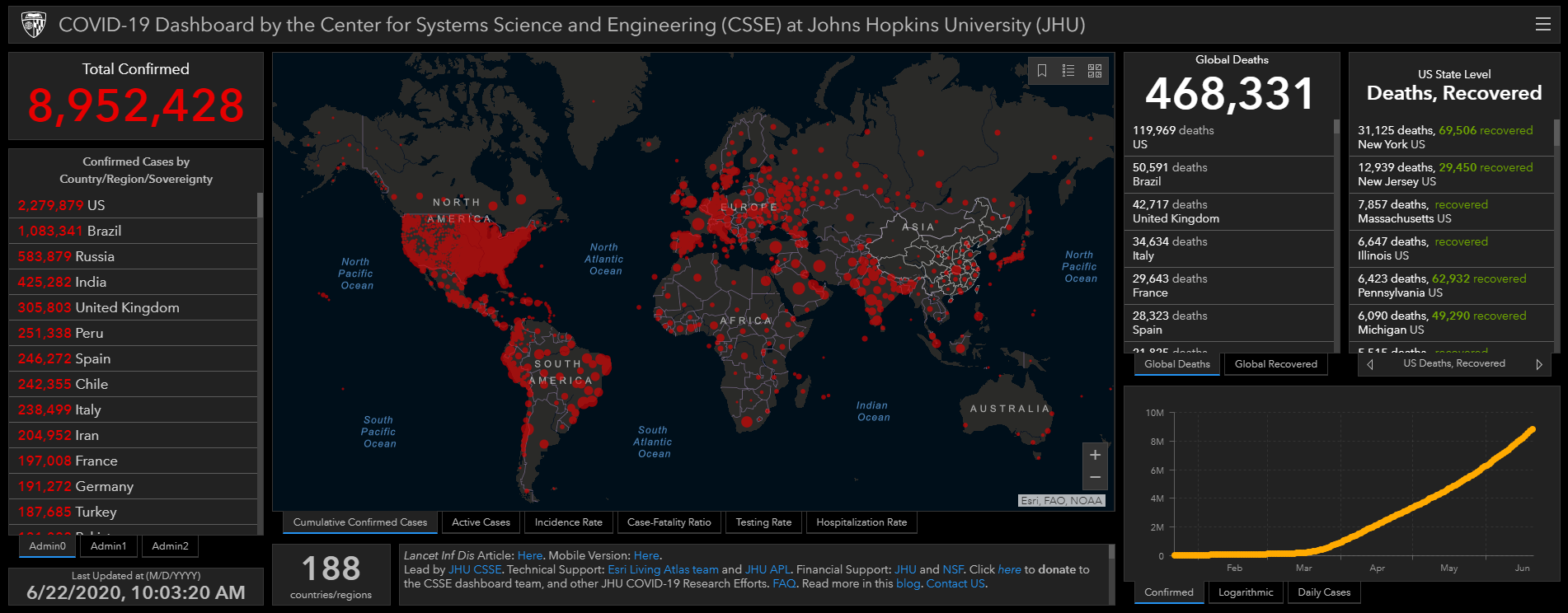
As per the recent Johns Hopkins statistics, there are more than 7 million cases across the world. In its infancy, China was the worst hit by COVID-19. However, in time, China started to recover and Italy saw a rise in the number of infections. From there, it made its way to Spain and the rest of the EU. Now the United States of America has become the most affected country in the world followed by Brazil. India is the 4th most-affected country. While almost all countries have been affected to some extent, smaller, developed countries such as New Zealand and Denmark have been able to effectively control and minimise infections.
Prevalence of COVID-19 in the world and India
Current known/tested numbers of COVID-19 cases globally and in India:
| S. No. | Region | Number of Cases as of 20 June 2020 |
| 1 | World | 8,952,428 |
| 2 | India | 425,282 |
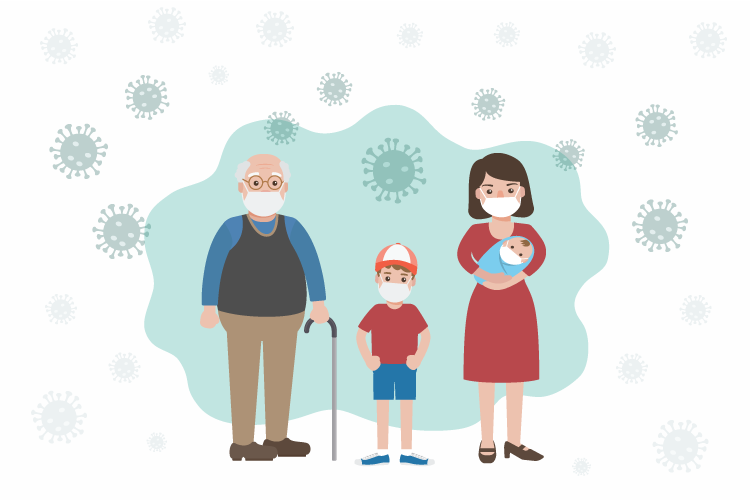
Who is at risk of COVID-19?
There is no denying that coronavirus can affect people of any age group. However, getting infected depends on multiple factors.
- Firstly, it highly depends on the location and prevalence of COVID-19 outbreak in that location.
- Secondly, it can easily target elderly people and those who suffer pre-existing medical conditions such as asthma, diabetes, heart disease, and obesity.
- Thirdly, as per recent research at Brown University, people who are bald can also be at higher risk of infection.
Diagnosis of COVID-19
If an individual suspects that he/she has been exposed to novel coronavirus (COVID-19), and has developed any symptoms (cough, fever or difficulty breathing) can go for diagnosis. There are two different ways for diagnosis
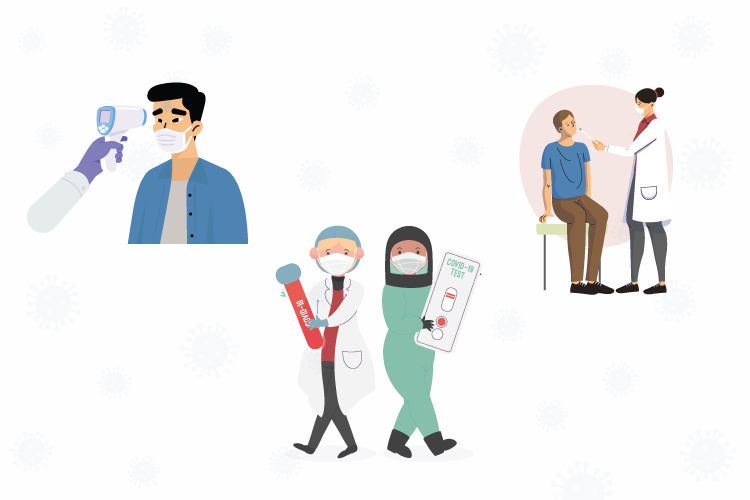
Laboratory
For patients who meet diagnostic criteria for SARS-CoV-2 testing, the CDC recommends collection of specimens from the upper respiratory tract (nasopharyngeal and oropharyngeal swab) and, if possible, the lower respiratory tract (sputum, tracheal aspirate, or bronchoalveolar lavage). In each country, the tests are performed by laboratories designated by the government.
These samples are then assessed for viral RNA using polymerase chain reaction (PCR). If a positive test result is achieved, it is recommended to repeat the test for re-verification purposes. A negative test with a strong clinical suspicion also needs repeat testing.
Radiology
Radiology findings may vary with patients’ age, disease progression, immunity status, comorbidity, and initial medical intervention. Data from studies indicate that the typical set of chest CT-scan findings are bilateral pulmonary parenchymal ground-glass and consolidative pulmonary opacities; the consolidated lung lesions among patients five or more days from disease onset and those 50 years old or older compared to 4 or fewer days and those 50 years or younger, respectively.
Management and Treatment for COVID-19
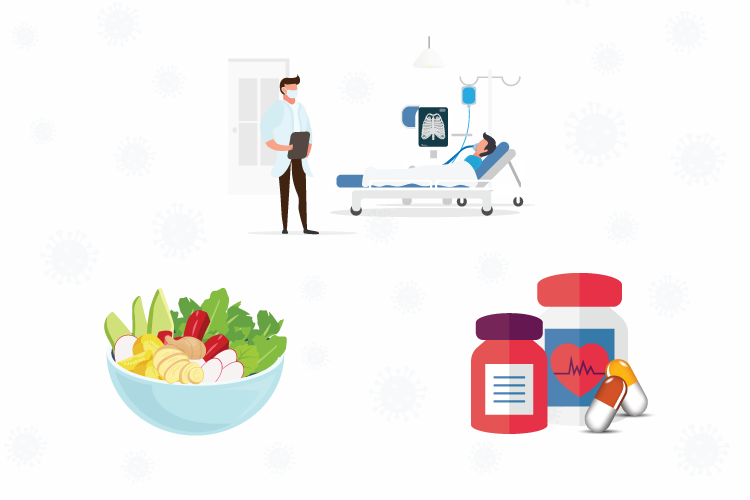
There is no special vaccination or specific treatment for COVID-19 yet. Health professionals are following supportive therapy which includes isolation and administration of antipyretic and analgesic, fluid management, mechanical ventilation as respiratory support, and uses of antibiotics in bacterial infections. Therefore initial management of COVID-19 deals with the early recognition of the suspect and contains the disease spread by immediate isolation and infection control measures. The management of the disease has been mostly supportive referring to the disease severity which has been introduced by WHO.
If you feel sick, get enough rest and sleep, drink plenty of fluid, and eat nutritious food. Involve in some physical exercise or yoga. Stay isolated and in a separate room from family members and if possible use a dedicated bathroom. Always clean and disinfect frequently touched surfaces.
Maintain a healthy lifestyle, stay active, and connect with friends and family, such as with phone or video calls. Do activities you enjoy, such as reading a book or singing, dancing or art and craft.
If you have mild symptoms and are otherwise healthy, self-isolate and contact your doctor or a COVID-19 information line for advice right away.
Currently, no medication is recommended to treat COVID-19, and no cure is available as researchers are testing a variety of possible treatments.
As clinical studies are still on, the FDA has granted permission for some medications approved for other diseases to be used to treat severe COVID-19. Two malaria drugs — hydroxychloroquine and chloroquine; antimalarial drugs and an antiviral drug, remdesivir, have been approved for this use.
Treatment is directed at relieving symptoms. There is no evidence and documented data for COVID treatment. General treatment includes a combination of
- Pain relievers -ibuprofen or acetaminophen, nonsteroidal anti-inflammatory drugs (NSAIDS)
- Cough syrup
- Rest and fluid intake
- Supplement therapy like Vitamin D, Calcium and Iron
Importance of Quarantine
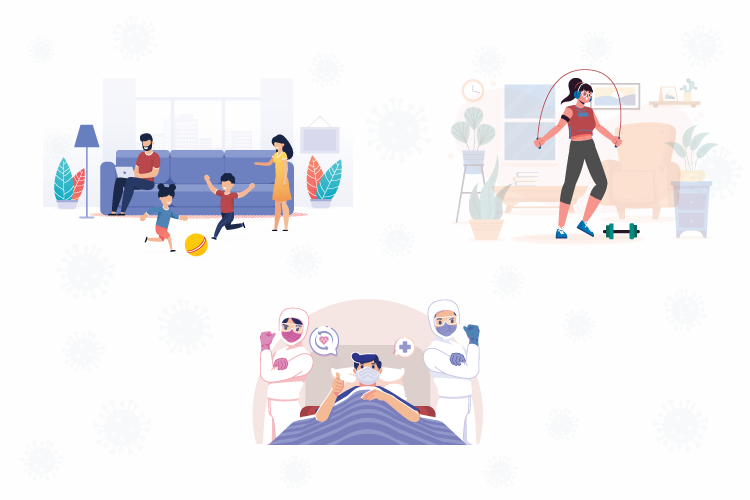
Currently, as there are no effective medicines or vaccines available to treat or prevent COVID-19. Isolation, physical distancing, and quarantine have been used in several countries to reduce transmission of the virus as restrictive public health measures. Isolation is the separation of people with symptoms from others. Quarantine is the restriction of people who are asymptomatic but who have had contact with confirmed or suspected individuals of infection. Quarantine is also recommended for those who have been from the most affected area or region. Quarantine can (and should) be voluntary or can be legally enforced by authorities, and it may be applied at an individual, group, or community level.
Psychosocial Support
People who are in lockdown are susceptible to certain psychological disorders which start with symptoms such as lack of sleep, mood swings, stress, anxiety, anger, depression, irritability, inability to make decisions, poor concentration, and confusion. They occur due to lack of exposure to the outside environment, inability to meet near and dear ones, lack of access to social entertainment (parks, malls, etc), fear of getting infected, and financial insecurity. It is necessary to stay at home in this crucial period to avoid the spread of diseases and prevent community transmission.

While staying at home, it is essential to stay mentally and physically fit, where family and individuals play a key role. Listed below are the health impacts and tips to overcome them:
Impact- Anxiety
- Recognize your fears and ensure preventive measures.
- Manage your day by planning your daily tasks in advance.
- Make time to indulge in your favorite activity/hobby to help you relax.
- Maintain short breaks in your workflow to help you with clarity of thought at work.
Loneliness
- Stay connected with your friends and family.
- Pen down your thoughts whenever you feel lonely.
- Join the local community groups digitally, make new friends and chat with people on interactive platforms.
- Keep yourself engaged in some activity, like a new hobby, and learn something new every day.
Lacking motivation and concentration
- Remember, it takes time to adapt.
- Indulge in Yoga and some simple exercises for at least one hour per day.
- Practice meditation to help you improve concentration.
- Read some motivational books online and implement the lessons from them to keep you motivated.
Stress Threshold
- Don’t forget that your physical and mental health are of utmost importance.
- Do exercise regularly, consume healthy food and sleep thoroughly.
- Indulge in practicing meditation to fight back stress.
- Talk to your favorite people.
Negative Emotions
- Do not trust the media completely.
- Do not check the latest COVID statistics frequently.
- Seek help in case you feel isolated.
- Make 1 hour every day for breathing exercises and meditation.
Desperation
- Engage in practicing yoga and exercises to break the feeling of desperation to have cigarettes or alcohol amid COVID-19.
- Distract yourself when you feel the urge to smoke or drink by involving in family discussions and some playtime.
Panic and fear
- Do not panic at any cost as everyone is passing through the same phase.
- Be brave to challenge your fear, and ask for help when you need it.
- In case you are unable to cope up with the situation, consult the doctor.
Why do Indians have a strong immunity against infections?
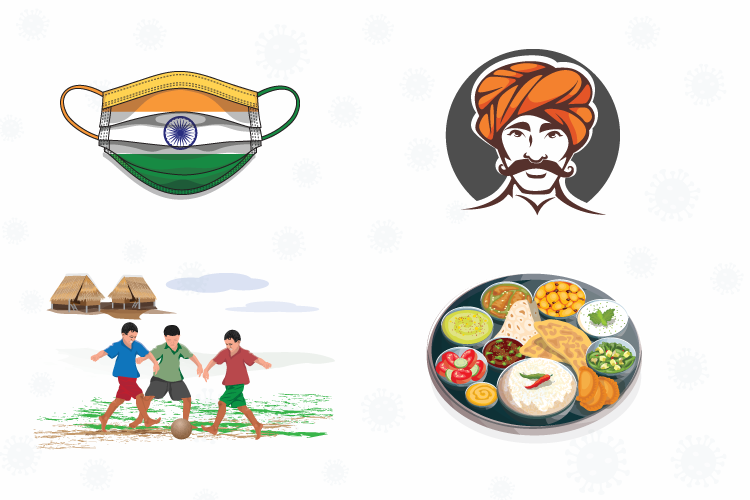
It is suspected that Indians may have high immunity levels due to exposure to harsh environments, (pollution & bacterial load) from childhood, Indian food, and traditional hygiene habits.
Environment and Pathogens
In Indian Scenario, children are allowed to play in the sand and get exposed to various bacteria and pathogens. Unknowingly, few enter their body and start developing antibodies naturally to fight the infection. Exposure to sunlight nutritional intake, which is the key factor for developing immunity, as a cultural practice for infants and outdoor games when they grow older, helps to improve their nutritional status which is a key to good immunity status. Excess sweating due to the humid weather and activities helps to release the excess toxins from the body via sweat, which will hamper the immunity if not excreted.
Indian Food Habits
Any Indian cuisine will incorporate a wide range of spices to improve the taste of food as well they own a health benefit on its own. For example, the traditional spice in Indian cooking is Turmeric, which contains an active compound called curcumin, which is anti-inflammatory and antibacterial. Turmeric is consumed internally and also used externally for wounds to heal. There are many other Indian spices each having a specific health benefit, some commonly found Indian herbs & spices are pepper, garlic, nutmeg, jeera, ginger, tulsi, and dry ginger.
Self-Analysis of your Immune System
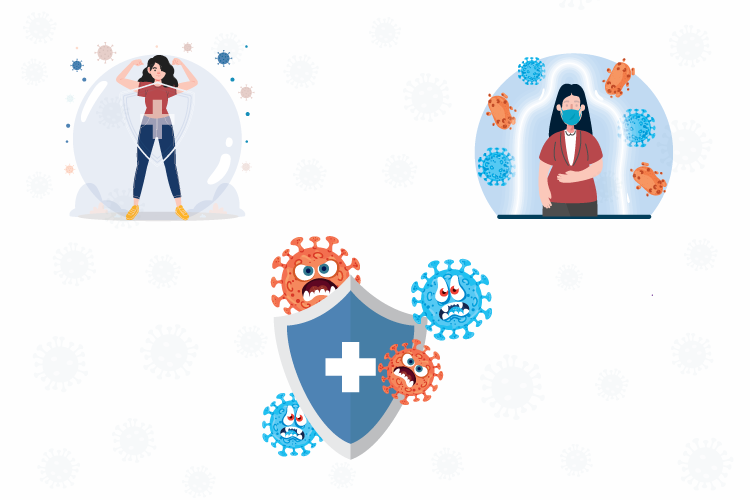
The self-analysis aims to help you with recognising the status of your immune system. All you have to do is rate yourself based on the frequency of the symptoms in a month and find out the health of your immune system.
- Cough/Cold
- Fever
- Anemia
- Indigestion
- Bloating
- Nausea/ Vomiting
- Vitamin Deficiency
- Disturbed Sleep
- Lack of Physical Activity
- Headache
If you experience the mentioned symptoms more frequently, it means that your immune system needs extra care to become healthy.
Improve your Immunity naturally
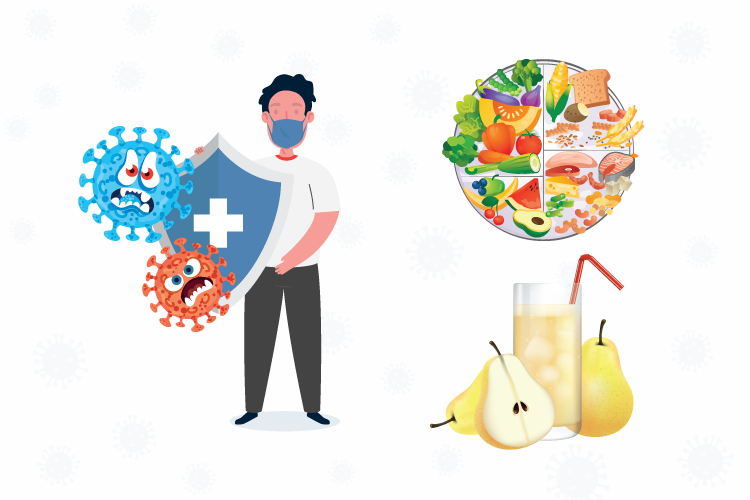
Dietary Support
The role of diet in the development of the immune system is very crucial. Consuming only nutrients like carbs, fats, and proteins, is not enough, instead a person should include micronutrients in his diet.
Key Nutrients to Boost Immunity
Micronutrients are important because they are the base for building up immunity. Below is the list of micronutrients that one must include in one’s diet:
Carotenoids
These are very important for our body as they are rich in antioxidants that help strengthen the immune system and fight against infections. Major food sources of Carotenoids include Carrots, Sweet Potatoes, Oranges, Pumpkin.
Vitamin C
Vitamin C has its own significant role to play. It acts as a powerful immunity booster from being rich in antioxidants. Daily intake of Vitamin C enables the various cellular functions of the immune system to perform efficiently that further contribute to immune defense. Major food sources of Vitamin C include Citrus fruits (such as Orange and Grapefruit), Kiwi, Broccoli, Strawberries.
Vitamin D
Vitamin D is essential to reduce the risk of viral and respiratory infections. Vitamin D can modulate the immune responses by maintaining optimal blood levels of calcium and phosphorus. Major food sources of Vitamin D include Egg Yolk, Fatty Fish, Cheese, Mushroom. Vitamin E
Vitamin E acts as an antioxidant and helps the body in warding off the infections. It prevents cell damage and supports the body’s natural immune system. Major food sources of Vitamin E include Almonds, Wheatgerm oil, Sunflower seeds.
Zinc
Zinc is essential for the development and proper functioning of immune cells. Being an antioxidant, it controls the inflammation in the body and helps in the production of white blood cells. Major food sources of Zinc include Oysters, Cashews, Chickpeas.
Omega 3 Fatty Acids
Omega 3 fatty acids are necessary to consume for keeping the immune system in check. They play a vital role in enhancing the immune B cells. Major food sources of Omega 3 Fatty acids: Fatty Fish, Walnuts, Flaxseed oil.
Folate
Folate is one of the most essential yet neglected nutrients. It is important for the production of body cells and further helps in making and repair of DNA to prevent cancer. Major food sources of Folate include Legumes, Green Leafy Vegetables, Citrus Fruits.
Selenium
Selenium is essential for the body for optimal functioning of the immune system. It also improves the functioning of the thyroid gland and protects the cells against oxidative damage, bacteria, viruses, and parasites. Major food sources of Selenium are Fish, Brown Rice, Eggs.
- Foods To Include in your Daily Diet
Citrus Fruits
- Rich in Vitamin C, antioxidants, and bioflavonoids which inhibit the activity of viruses.
- Sources – Orange, Gooseberry, Sweet Lime, Lemon, Strawberry, Custard Apple
Dark Coloured fruits and vegetables
- Colour of the food corresponds to the particular pigment and their antioxidant property.
- Sources – Red and Green Bell Pepper, Broccoli, Carrots, Lettuce, Grapes, Watermelon
Dairy & its Products
- Rich in Vitamin D, Calcium & protein that helps to strengthen the immune system
- Sources – Milk, Curd, Buttermilk, Yogurt, Kefir
Pulses, Seeds and Nuts
- Rich in Zinc, Magnesium which have anti-inflammatory properties.
- Sources – All pulses, Flax Seeds, Sunflower Seeds, Walnut, Almonds
Herbal tea
- Contains a potent antioxidant called catechin which helps in boosting immunity.
- Sources – Green Tea, Chamomile
Fatty Fish
- Omega 3 Fatty acid content in fishes helps in the proliferation of immune cells
- Sources – Salmon, Tuna, Trout, Sardines, Mackerel
Probiotics
- Helps to maintain the gut microflora which fights against viruses and bacteria that pass through the digestive system.
- Sources – Yogurt, Kefir, Sauerkraut, Kimchi.
Immunity Boosting Recipes
Detox Green Smoothie
Ingredients:
- 1 cup roughly chopped Spinach
- 1 cup Unsweetened Almond Milk
- 1/2 diced Pineapple
- 1 cup Kiwi
- 1/2 teaspoon freshly grated Ginger
- 1/2 tsp Lemon Juice
Method: Add all the ingredients and blend until smooth.
Benefits:
- Detoxifies the body
- Boosts metabolism
- Strengthens immune system
- Supports colon and gut health
- Promotes clear and radiant Skin
Citrus Fruit and Turmeric Juice:
Ingredients:
- 2 small Oranges
- 1 small Lemon
- 1 small Sweet Lime
- 1 tsp sliced Ginger
- 1/2 tsp ground Turmeric
- 1 tbsp Honey
- A pinch of Salt
Method:
- Add all ingredients and blend until no pieces of Ginger or Citrus remain.
- Add ice cubes and serve.
Benefits:
- Improves metabolism
- Detoxifies liver
- Low in calories
- Boosts immunity
- Aids in weight loss
Immune Boosting Soup/ Broccoli and Almond Soup:
Ingredients:
- 2 cups Broccoli
- 2 Celery Stalks
- 2 tbsp Almonds
- 2 medium Onions
- 2 Carrots
- 4 cloves of Garlic
- 2 cups Low Fat Milk
- Salt to taste
- Pepper to taste
- Water as required
Method:
- Wash and chop all the vegetables.
- Dry roast the almonds on low flame and chop after cooling.
- Boil chopped vegetables on medium flame for 15 minutes.
- Once tenderized, cool and blend them into a puree.
- Add milk to it and bring to a boil.
- Once done, add salt and pepper in the soup and serve hot!
Benefits:
- Boosts immunity
- Fights inflammation
- Detoxifies the body
- Removes toxins from blood
- Improves overall health
Sweet Potato Hummus
Ingredients:
- 1 medium Sweet Potato peeled and cubed
- ½ teaspoon Turmeric
- ¼ teaspoon Ground Cumin
- ¼ teaspoon Smoked Paprika
- 3 cloves of Garlic
- ½ Lemon juiced
- 1 cup of boiled Chickpeas
- 1 tablespoon Tahini
- 2 tablespoons Olive Oil
- Salt to taste
- Pepper to taste
Method:
- Preheat the oven to 175ºC / 350ºF.
- Toss the Sweet Potatoes with Spices and Garlic and bake for 30-40 minutes until tender.
- Let it cool and add to a food processor with remaining ingredients, except the Olive Oil.
- Blend until combined and while blending slowly drizzle in the Olive Oil until smooth.
Benefits:
- Rich in Vitamin B & C
- Regulates blood sugar levels
- Chock-full of health proteins
- Help reduce inflammation
- Excellent source of fiber
Lentil Salad
Ingredients:
- 2 cups of Dry Lentils
- 1 Bay Leaf
- 4 cups of Water
- 1 cup Spring Onions Diced
- 1 Onion, finely chopped
- 1 Red Bell Pepper chopped
- 1 Bunch Coriander, finely chopped
For Dressing
- 1 tbsp Olive Oil
- 1 tbsp Honey
- 2 Garlic Cloves
- ½ tsp Turmeric
- ½ tsp Cumin
- Salt to taste
- Pepper to taste
Method
- Add Lentils, Bay Leaf, Water and Salt into a pan and bring to a boil.
- Lower the flame, cover and cook for 25 – 30 minutes or until the lentils are tender. Drain and let it cool.
- Add cooked Lentils, Spring Onions, Onion, Bell Pepper and Coriander into a large bowl.
- Mix the dressing ingredients and add to the mixture.
- Mix all the ingredients properly and serve.
Benefits
- Regulates bowel movement
- Inhibits the production of inflammation
- Lowers the risk of heart disease
- Improves one’s sleep
- High source of antioxidants
Daily Habits to Strengthen Immunity
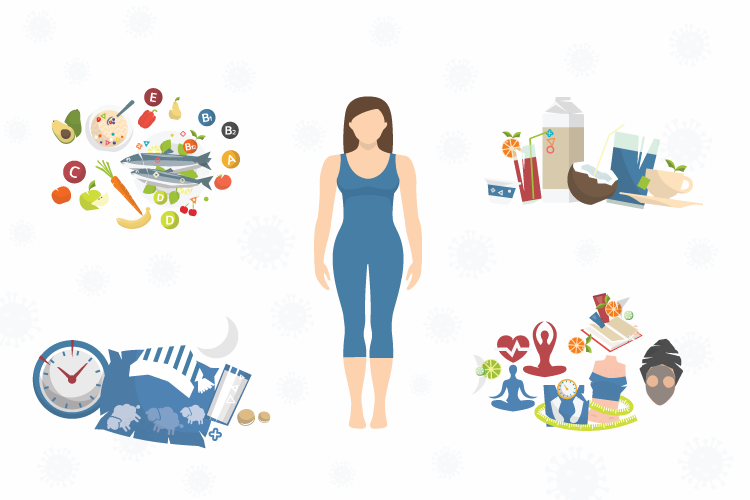
- Drink an adequate amount of water to keep yourself hydrated. Water helps to flush out the toxins, viruses, and bacteria from the body. Drink at least 2-3 litres of water per day. Avoid drinking water only when you are thirsty, instead, consume sips of water frequently
- Sleep for a minimum of 7-8 hours per day, Practise to sleep in the nights as many wear and tear processes of the body take place at that time. Staying awake and sleeping in the day time may induce disorders
- Exercise moderately and regularly, avoiding or overdoing will affect your body
- Maintain ideal weight, if you are overweight this is the right time to shed those extra pounds. Lose or maintain by right diet, exercise, and lifestyle.
- Manage stress, if you fail to do so it will weaken the immune system. During stress, the body produces cortisol which will trigger inflammation in the body and weakens the immune system. Practice yoga or meditation as per your choice
- If you are suffering from any other health complication please do take medications regularly and follow precautions as suggested by your physician.
- Think positive and stay calm which will help to overcome the situation. Keep yourself occupied with some sort of activities to avoid loneliness.
- Avoid smoking and alcohol as it may further put you at a high risk of infections.
Tips For Healthy Living
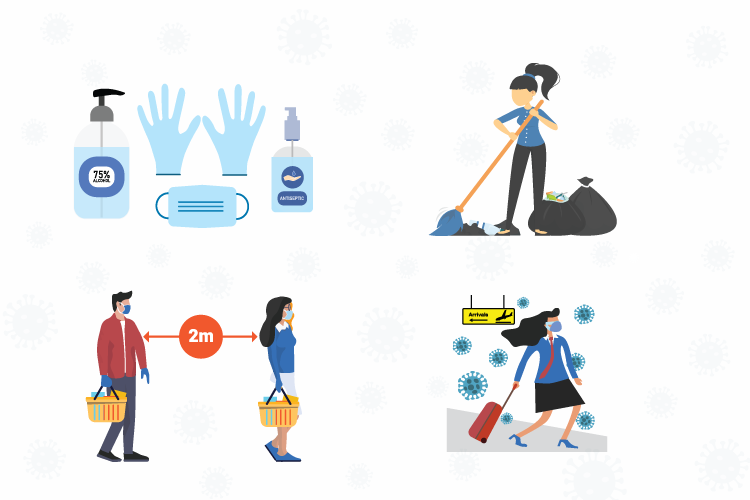
Dietary Tips To Boost Immunity
- Consumption of fresh and unprocessed foods every day
- Avoid the consumption of unprocessed foods
- Consume foods such as fresh fruits and vegetables, legumes (e.g. lentils, beans), nuts and whole grains
- Opt for raw vegetables and fresh fruits rather than foods that are high in sugar or salt for snacking
- Use cooking methods such as sauteing, steaming and boiling instead of microwaving
- Consumption of moderate amounts of fats and oils
- Limit the consumption of red meat which is a source of high fat
- Increase the consumption of nuts in the diet as they are a good source of unsaturated fats
- Opt for low-fat dairy products
- Avoid the consumption of trans fats
- Consumption of less salt and sugar
- Limit the amount of salt and sugar during cooking and preparation of foods
- Reduce the salt intake to 5g/day
- Avoid the consumption of deep-fried foods which reduce immunity and dehydrate the body
- Choose fresh fruits instead of snacks that are high in sugar
Personal Hygiene Tips
- Maintain Personal Hygiene – Wash hands after you touch any object or surfaces
- Start your day by consuming water or fresh fruit/ vegetable juices
- Cook fresh meals, avoid refrigerating and freezing cooked foods
- Practice breathing exercise; 5 reps in the morning and 5 reps in the evening
- Don’t share your cutlery or clothing with the family members
- Spend more time with family and listen to their thoughts, share ideas to prevent loneliness
- Manage your working hours and family time
- Add colours to your plate by consuming fruits and vegetables of different colours
- Consume at least 2 servings of fruit per day
- Drink adequate water in the form of juice, soups, buttermilk, tender coconut water
- Avoid smoking and alcohol consumption
- Practice sleeping during the night, avoid late-night sleep/ day time sleep
- Improve your eating habits
- Allot a particular time for exercise with all family members to feel motivated
- Do not overcook foods as they lose their nutritional value
- Avoid overeating
- Consume 1 cup of herbal tea per day
Food Hygiene Tips
- Consume freshly cooked and hot food
- Eat more local, seasonal and traditional Indian foods
- Carry your own bags to buy groceries, fruits and vegetables. Wash immediately with water after you empty it.
- Soak all fruits and vegetables in luke water salt and turmeric water, later wash with fresh water prior to cooking or storing.
- Wash all packed foods (curd, milk, bread, cereal etc) with normal water before storage
- Avoid buying cut fruits and vegetables (eg- watermelon, pineapple, pumpkin etc), buy it whole.
- Buy fruits such as banana and grapes as a bunch and with stems intact
- Avoid ordering or eating fruit and vegetable salad from outside
- Stay away from canned and processed foods
- Cook meat & Meat products up to 100-degree celsius, pressure cooking is ideal.
Environmental Sanitation Tips
- Clean high touch surfaces such as doorknobs, handles, switches, mobiles, computer mouse, laptops, remote controls and toys with disinfectants
- Clean the floorings with detergent water first followed by disinfectants
- Clean bedspreads, linens with hot water and detergent, and sundry them
- Maintain social distancing at all times
- Don’t sneeze or cough in an open environment, which may pollute the air.
- Always use a closed bin and clear the bin on a daily basis
- Keep walkways, corridors, and roads clean; avoid littering
- Avoid touching handles with hands, wear gloves or use elbows to touch these surfaces
- Avoid overcrowding in one particular area or counter while shopping
- Wear a face mask always when you step out of the house
- Insist others to maintain social distancing if they don’t
- Carry your own napkins and sanitisers when you go out
- Avoid eating outside, if unavoidable eat only foods that are hot and freshly prepared
- Replace cash transactions with online payments
- If you’re sick avoid going out
Tips for Safe Travel
- Sanitize your hands by washing them frequently with warm water and soap
- Drink only bottled water and drink frequently
- Consume only thoroughly cooked foods and avoid eating raw foods, and openly stored foods
- Ensure the food to be consumed has undergone a quality check
- If you develop any symptoms of illness, immediately report to the concerned authorities when travelling
- Don’t Touch your eyes, mouth, nose frequently; if required, wash your hands first
- Carry your own food for short distance travels
- Individuals with pre-existing health conditions, senior citizens, children below age 10 should avoid travelling, travel only if unavoidable
- Collect details about the destination with respect to COVID-19 eg: number of active cases, nearby hospitals etc
- Download the tracker app if available
Community Awareness Tips
- Staying away from neighbours if infected: If any neighbour is infected with COVID-19, stay away from them and their family members. Clean your house daily with disinfectants. Leave the house as little as possible and complete all your purchases in one trip.
- Maintain a diary and make a list of people who visited you when a case has been tested positive in the neighbourhood. This will help to trace the source if required in the future
- Let your home bathe in the sunlight which is a natural disinfectant. Keep the windows open for good ventilation and sunlight
- Do not ostracize and look down upon individuals that have been infected. Offer your support (emotional, financial and mental) through a difficult time for them, while ensuring you maintain physical distance.
All in all, taking precautionary measures is the best way to prevent this global pandemic. The Fit Indian is trying to keep the people healthy by sharing such information. Please share it with your friends, family and relatives.

Compiled by
Dr Vrushali Pulate (PhD in Bio process Technology)
Technical Content Director and Product Head
Pyrite Fitness Pvt. Ltd.
Her research interests are biosurfactants, pharma biotech, food sciences, analytical chemistry with five international publications in peer-reviewed journals. Awarded research fellowship DBT- India (2007-2009) and UGC-SAP- Delhi India (2009-2014).
Frequently Asked Questions
You can keep yourself safe from Coronavirus by following the below steps:
a.) Wash your hands for at least 20 seconds with soap and water
b.) Always keep alcohol-based sanitizer handy in case soap and water are not available
c.) Cover your mouth and nose with a bent elbow while coughing and sneezing
d.) Maintain a safe distance from a sick person
e.) Stay at home if you feel unwell and seek medical attention.
For a safe grocery shopping, follow the below steps:
a.) Avoid frequent grocery shopping
b.) Avoid visiting the store during rush hours
c.) Avoid touching the items that you do not want to buy
d.) Avoid going in a group as it may make you stay longer in the store and potentially catch the infection
It is very important to maintain food hygiene in the time of COVID-19. Follow the below written essential steps to wash fruits and vegetables:
a.) Make sure to wash your hands before handling the fruits and vegetables
b.) Wash it the same way as you were doing in daily routine i.e. washing them thoroughly with water
c.) Use a brush or sponge if necessary
d.) Do not use any soap, shampoo or detergent for washing them since these are harmful for consumption
There are chances of virus transmission from coins and currency notes. Though the virus lives for only 24 hours on the same, it may infect someone who will handle the money manually. You are advised to avoid any physical transactions. However, in case you do, you should wash your hands thoroughly before and after handling money.
Yes, handshaking should be avoided because it’s through our hands that germs and viruses can easily enter our bodies and make us unwell.
Wearing rubber gloves is not the right way to prevent the new coronavirus infection. The virus may survive on the surface and can enter your body. However, washing your hands with soap and water frequently and thoroughly is the most effective way to prevent the infection.
All three terms have their own significance in the time of COVID-19.
Self Isolation – This means isolating yourself when you know you are infected, to avoid the spread of the infection to another person.
Self Quarantine – This means restricting yourself from coming in contact with people when you have reason to suspect an infection but are asymptomatic.
Social Distance – This means you are simply avoiding large gatherings, be it at home or outside. You can maintain effective social distance by keeping 6 feet distance from the other person.
There is no vaccine or treatment for COVID-19 as of yet. However, efforts are underway to develop a vaccine or treatment. And we, as much as the next person, hope this happens soon.
- https://www.cureus.com/articles/27924-coronavirus-covid-19-a-review-of-clinical-features-diagnosis-and-treatment
- Journal of Infection and Public Health – http://www.elsevier.com/locate/jiph
- https://www.immunopaedia.org.za/breaking-news/indian-population-could-have-intrinsic-immunity-to-resist-covid-19-challenge/
- https://www.sciencedirect.com/science/article/pii/S1876034120304329
- https://jamanetwork.com/journals/jama/fullarticle/2764727
- https://www.ncbi.nlm.nih.gov/pmc/articles/PMC7090728/
- http://www.ijmr.org.in/article.asp?issn=0971-5916;year=2020;volume=151;issue=2;spage=147;epage=159;aulast=Chatterjee
- https://www.ncbi.nlm.nih.gov/pmc/articles/PMC7151434/
- https://www.who.int/docs/default-source/coronaviruse/mental-health-considerations.pdf?sfvrsn=6d3578af_2
- https://www.schengenvisainfo.com/news/coronavirus-how-to-stay-safe-on-your-travels/
- https://www.unicef.org/coronavirus/cleaning-and-hygiene-tips-help-keep-coronavirus-covid-19-out-your-home#cleaning-home
- https://www.mayoclinic.org/diseases-conditions/coronavirus/diagnosis-treatment/drc-20479976